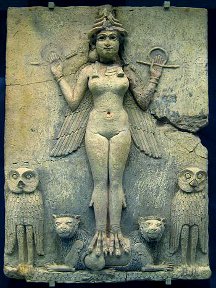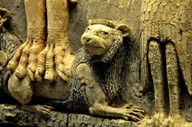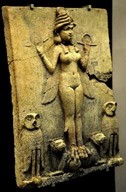|
 Queen
of the Night Oil Queen
of the Night Oil
This mysterious and beautiful terracotta plaque is hailed as a masterpiece of ancient Mesopotamian art. Known as The Queen of the Night and dated to the Old Babylonian period (likely between 1800 and 1750 BCE), there has been much debate about who is pictured. Is she death-goddess Ereshkigal, Queen of the Underworld? Or Innana (Ishtar in Akkadian), the Sumerian Queen of Heaven and Earth? The feminine figure has scaled and feathered wings that drape down her back like a cloak. Her feet—three-toed talons that resemble the owls that flank her—perch upon a pair of lions. She wears a four-horned headdress topped with a disc, signifying divinity, and holds a rod and ring. Could her bird-like features represent Lilith? Or Kilili, the harlot who comes out at dusk? Did this incredible image once feature in the house altar of an ancient brothel? Who is the Queen of the Night? We don't know.
What we do know is that this Queen of the Night reaches beyond the normal order of things. The human shaping of her face and torso are unified with her very non-human claws and wings, shattering boundaries between species, and human and divine. She is a liminal figure.  To us, she imbues the rational with the animalistic, the ceremonial with the carnivalesque, and the lofty divine with the muckiness of earth. Though we don't know who created her, where she was unearthed, or even who she represents, we are deeply drawn to her. And we are humbled by her power to free us from getting caught up in our limiting ideas of what the divine and our relationship with it "should be." This magic oil is our humble attempt to honor the Queen of the Night's inscrutable spirit and—we hope—to welcome and celebrate the "endless potentiality of dirt and the pure possibility of liminality"** which has been our evolving experience working with her. To us, she imbues the rational with the animalistic, the ceremonial with the carnivalesque, and the lofty divine with the muckiness of earth. Though we don't know who created her, where she was unearthed, or even who she represents, we are deeply drawn to her. And we are humbled by her power to free us from getting caught up in our limiting ideas of what the divine and our relationship with it "should be." This magic oil is our humble attempt to honor the Queen of the Night's inscrutable spirit and—we hope—to welcome and celebrate the "endless potentiality of dirt and the pure possibility of liminality"** which has been our evolving experience working with her.
T his oil begins with lush, wet night-blooming flowers, including jasmine sambac and flowering tobacco, which are combined in a base of fractionated coconut oil that has been infused with sacred datura—another night-bloomer, mandrake root—for its Saturnian and underworldly qualities, and orris root.* We then add divinatory clary sage, green and damp violet leaf, and others, including costus root, which lends a pleasingly rank and sensual quality. The result is an oil that evokes a lush, mysterious encounter with the spirit of the Queen of the Night. Use it for honoring feminine spirits of the night and of the Underworld, shapeshifting, for help breaking free from limiting cultural "norms" (e.g., patriarchy, gender binaries), and for any work that requires you to transgress conventions on the path of being free. his oil begins with lush, wet night-blooming flowers, including jasmine sambac and flowering tobacco, which are combined in a base of fractionated coconut oil that has been infused with sacred datura—another night-bloomer, mandrake root—for its Saturnian and underworldly qualities, and orris root.* We then add divinatory clary sage, green and damp violet leaf, and others, including costus root, which lends a pleasingly rank and sensual quality. The result is an oil that evokes a lush, mysterious encounter with the spirit of the Queen of the Night. Use it for honoring feminine spirits of the night and of the Underworld, shapeshifting, for help breaking free from limiting cultural "norms" (e.g., patriarchy, gender binaries), and for any work that requires you to transgress conventions on the path of being free.
* Although datura and mandrake are poisonous, we use only a very small amount in the infusion so this oil can still be safely used as a lush, natural perfume.
**Barbara Babcock, from The Reversible World: Symbolic Inversion in Art and Society (Cornell University Press, 1978).
|
Queen
of the Night Oil
1/4 oz. (2 drams/7.5 ml) $19.00
Uses
in Witchcraft & Magic:
Honoring Deities of
the Night
Working with the Underworld
Shapeshifting and Transgressing Boundaries
Inviting the Sacred Feminine
Breaking Free from Limiting Influences
Using Magic Oils
© 2011-2023 Alchemy Works; No reproduction without permission
|
 Queen
of the Night Oil
Queen
of the Night Oil To us, she imbues the rational with the animalistic, the ceremonial with the carnivalesque, and the lofty divine with the muckiness of earth. Though we don't know who created her, where she was unearthed, or even who she represents, we are deeply drawn to her. And we are humbled by her power to free us from getting caught up in our limiting ideas of what the divine and our relationship with it "should be." This magic oil is our humble attempt to honor the Queen of the Night's inscrutable spirit and—we hope—to welcome and celebrate the "endless potentiality of dirt and the pure possibility of liminality"** which has been our evolving experience working with her.
To us, she imbues the rational with the animalistic, the ceremonial with the carnivalesque, and the lofty divine with the muckiness of earth. Though we don't know who created her, where she was unearthed, or even who she represents, we are deeply drawn to her. And we are humbled by her power to free us from getting caught up in our limiting ideas of what the divine and our relationship with it "should be." This magic oil is our humble attempt to honor the Queen of the Night's inscrutable spirit and—we hope—to welcome and celebrate the "endless potentiality of dirt and the pure possibility of liminality"** which has been our evolving experience working with her.  his oil begins with lush, wet night-blooming flowers, including jasmine sambac and flowering tobacco, which are combined in a base of fractionated coconut oil that has been infused with sacred datura—another night-bloomer, mandrake root—for its Saturnian and underworldly qualities, and orris root.* We then add divinatory clary sage, green and damp violet leaf, and others, including costus root, which lends a pleasingly rank and sensual quality. The result is an oil that evokes a lush, mysterious encounter with the spirit of the Queen of the Night. Use it for honoring feminine spirits of the night and of the Underworld, shapeshifting, for help breaking free from limiting cultural "norms" (e.g., patriarchy, gender binaries), and for any work that requires you to transgress conventions on the path of being free.
his oil begins with lush, wet night-blooming flowers, including jasmine sambac and flowering tobacco, which are combined in a base of fractionated coconut oil that has been infused with sacred datura—another night-bloomer, mandrake root—for its Saturnian and underworldly qualities, and orris root.* We then add divinatory clary sage, green and damp violet leaf, and others, including costus root, which lends a pleasingly rank and sensual quality. The result is an oil that evokes a lush, mysterious encounter with the spirit of the Queen of the Night. Use it for honoring feminine spirits of the night and of the Underworld, shapeshifting, for help breaking free from limiting cultural "norms" (e.g., patriarchy, gender binaries), and for any work that requires you to transgress conventions on the path of being free.